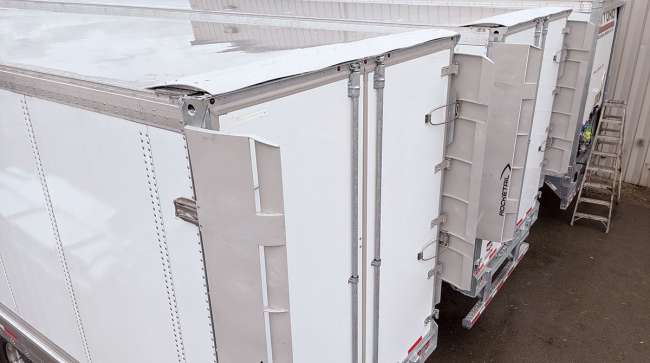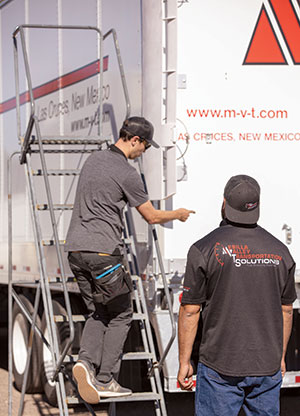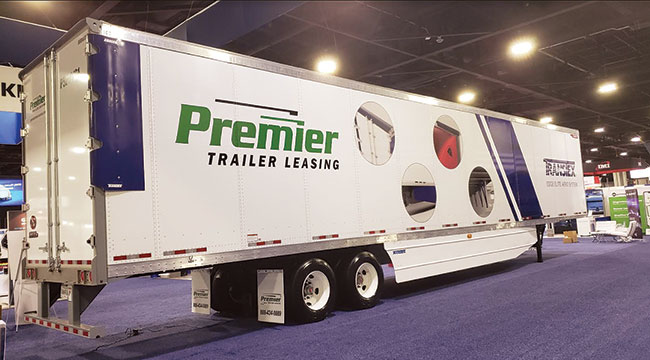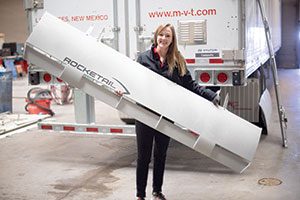Options Expand for Trailer Aerodynamics

[Stay on top of transportation news: Get TTNews in your inbox.]
Many trucking companies add various aerodynamic systems to their trailers to boost fuel economy, but how much fuel can these products truly save in real-world operating conditions?
Answering that question definitively is sometimes a challenge for fleet operators, but “investing in aerodynamics is one of the best things a company can do,” said Daryl Bear, lead engineer for Mesilla Valley Transportation Solutions, a company that tests and validates aerodynamics and other systems designed to save fuel.
In choosing what piece or combination of pieces to install, many factors must be considered, including the demands and hazards a company’s operations pose to such fittings, fleets and manufacturers said.
C.R. England, which operates about 6,300 trailers, including 5,000 temperature-controlled units, has used aerodynamic products from multiple manufacturers. Today the carrier uses a combination of trailer skirts, wheel covers and vented mud flaps.
“We break even on most of these technologies in less than two years,” said Ron Hall, vice president of equipment.
How much less than two years “depends on what fuel prices do,” he said.

MVT employees work on a trailer tail. (Mesilla Valley Transportation Solutions)
The 19-foot-long skirts that C.R. England uses yield a 3.5% savings in miles per gallon, Hall said. The wheel covers provide nearly 1% savings, and the vented mud flaps provide about 0.25% savings, he said. Combined gains from those aerodynamic fittings, then, come to almost 4.75%. Hall said the percentages were derived from CR England’s own “SAE-type fuel test program.”
The carrier began installing the skirts, manufactured by Transtex, four or five years ago after being dissatisfied with warranty support for skirts supplied by a different manufacturer, Hall said.
“Solid durability” and flexibility are essential in trailer skirts because “they tend to take a lot of impact,” Hall said.
Bracket design that enables the skirt to flex on impact and return to form while maintaining needed rigidity is crucial, he added.
C.R. England specs the skirts on new trailers, ordered from Utility Trailer Manufacturing and also from Wabash National and Great Dane. If a skirt must be replaced on an in-service trailer, C.R. England purchases direct from Transtex and handles the installation itself.
“What’s the enemy of a trailer?” asked Transtex CEO Mathieu Boivin. “It’s vibration.”
Transtex is preparing to introduce a horizontally ribbed skirt later this year. The ribs enhance the rigidity of the skirt, Boivin said. “A rigid skirt on the highway gives better fuel savings.”
Bear, of MVT Solutions, said trailer skirts have won increasing market acceptance over the past 10 years or so. “They’re very commonly used now.”

A Transtex ribbed side skirt on a Premier Trailer Leasing trailer at an industry show. (Transtex)
Utility Trailer, whose USS-120A side skirt is standard on its refrigerated and dry van trailers, this year went a step further by introducing its Utility Aerodynamic Tail. The rear fairing is designed to diminish turbulence and direct heat away from that portion of the trailer, which the manufacturer said is important for refrigerated trailers.
Utility said its latest tests showed that the USS-120A side skirts combined with the UAT can increase fuel efficiency by 8%.
The tail is self-deploying and self-retracting, said Brett Olsen, Utility’s marketing manager. “The driver does not have to do anything other than operate the rear door as normal,” he said.
The UAT is currently available in the aftermarket only through Utility dealers, and only for repair or replacement to trailers that were purchased with the UAT.
“We have not published installation instructions to the fleets,” Olsen said. “At this time only our dealers can [repair or replace] them.”
Of aftermarket availability, Olsen said, “That will come in the future.”
In its testing procedure, MVT Solutions measures fuel usage in gallons per thousand miles.
In its tests of side skirts on trailers, MVT sees fuel savings ranging from three gallons to about six gallons per thousand miles, Bear said. “A good one is around six.”

An employee holds up the Rocketail wing, demonstrating how light it is. (Rocketail)
Mckinney Trailer Rentals, which has an inventory of some 34,000 trailers, takes a pass on skirts for operational reasons, but it began putting tails on new trailers four or five years ago.
Richard Swenson, vice president of operations, said about 4,000 trailers have been equipped so far. The tails are less prone to damage than skirts, he said.
Mckinney doesn’t put skirts on its trailers because the trailers must be inspected each time they arrive and depart from McKinney’s premises, he said. “That’s part of our day-to-day protocol as a leasing company.”
Absent a skirt, the undercarriage of the trailer is more accessible for inspection.
The back end of trailers is increasingly a focus for many fleets and aero manufacturers. MVT’s Bear called it “the hot area right now.”
“The TrailerTail proved to everybody how much fuel you could save [there],” he said, referring to a rear faring product that was manufactured by Stemco.
EnPro Industries, Stemco’s parent company, announced during a Feb. 25 earnings presentation that it ceased operations related to its TrailerTail product line as part of an effort to improve financial performance.
The TrailerTail was first released in 2008 by aerodynamics supplier ATDynamics, which Stemco acquired in 2015.
FlowBelow, a supplier of aerodynamic fairings for tractors, has been expanding into the trailer market.
The company offers a “trailer aero package” that includes wheel covers and fairings.
FlowBelow recently brought in Rick Ruebusch as its CEO and announced that it intends to grow its market share in the tractor-trailer aerodynamics market, potentially through acquisition.
Mesilla Valley Transportation, the parent company of MVT Solutions, operates about 5,000 trailers and is using a mix of aerodynamic products, including skirts, tail kits and Eco Flaps, which are vented mud flaps.
After MVT Solutions tested the Michelin Energy Guard kit last year, the carrier began using it, Bear said. “It’s approaching 1 mile per gallon improvement,” he said.
The kit includes skirts with a bracket-and-slider design, trailer end fairings and a “wake-reducer” — a piece of hardware on the rear doors. Fleets can order the system through OEMs or for aftermarket installation.
Jason Koches, business development manager for aerodynamic solutions at Michelin North America, said most fleets have used service providers for aftermarket installation, “but fleets certainly can install the system themselves.”

The industry is struggling to attract a new generation of technicians to maintain and repair increasingly high-tech trucks. Seth Clevenger spoke in Atlanta with Technology & Maintenance Council President Robert Braswell and Chairman Stacy Earnhardt to find out who's fixing the trucks of tomorrow. Hear a snippet, above, and get the full program by going to RoadSigns.TTNews.com.
Installing the complete system takes 2.5 man-hours, he said.
MVT Solutions also tested a combination of a skirt, Eco Flaps and aerodynamic fittings made by Rocketail, a company in San Diego that makes side wings and a top fairing for the rear of trailers.
“We saw over 11 gallons [saved] per thousand miles with that package,” Bear said, or “around one mile per gallon.”
Dan Schley, chairman of Rocketail’s board, said the company’s wings are designed so that as the doors open, the wings “disappear into the gap between the door and the side of the trailer.”
When the doors are closed, the wings return to their aerodynamic position without any action required by the driver, Schley said.
MVT Solutions publishes the results of many of its fuel efficiency tests on its website, www.m-v-t-s.com.
The company measures results in gallons per thousand miles because percentage terms are “unreliable,” Bear said. “If you have a heavy load, you’ll see a lower [percentage] than if you have a light load. And if you have a driver that’s hard on the pedal and gets poor fuel mileage, they’ll get a lower” savings in percentage terms.
Bear also pointed out that some fleet operators conclude that, because their average truck speed is low, fuel savings from aerodynamics must be low. He cited a hypothetical example of a grocery company fleet operating in a city.
“They might spend three hours a day in traffic, and then drive 200 miles out of the city,” Bear said. “Those 200 miles are where all the fuel savings are” — where aerodynamic equipment yields optimal fuel savings.
Want more news? Listen to today's daily briefing:




